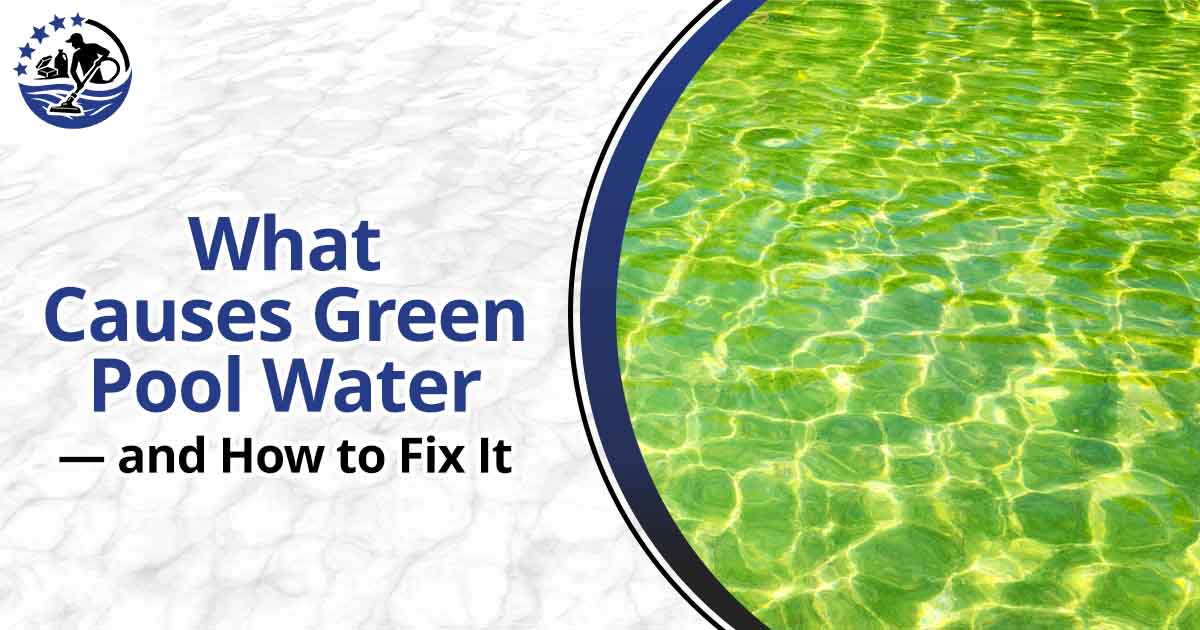If your pool is suddenly turning green, you’re not alone—and it’s a problem that can worsen quickly if left unaddressed. Green pool water is most often caused by algae, indicating that the pool’s chemical balance or filtration system may not be functioning correctly. While the discoloration may seem purely cosmetic, it often signals deeper issues with sanitation, water circulation, or environmental contamination.
Whether it’s a light green tint or a deep swamp-like appearance, identifying the root cause is the first step to restoring water clarity and safety. This guide walks pool owners through the common causes of green pool water, how to fix it, and when, especially if the problem persists. Our upcoming directory will help you find qualified local professionals to assess and resolve recurring issues.
What Does It Mean When Your Pool Turns Green?
A green pool isn’t just unsightly—it’s an indication that your pool water is chemically or biologically out of balance. Algae growth is the most common culprit, but other factors can contribute to the problem. Recognizing the early signs and understanding their significance can help prevent the issue from escalating into a more significant maintenance challenge.
Signs of a Green Pool Beyond Just Color
While the green hue is the most obvious warning sign, several other indicators can point to a developing algae problem:
- Cloudy or murky water may appear alongside a green tint, indicating the presence of suspended particles or contaminants.
- Slimy pool walls or steps suggest algae buildup that’s beginning to adhere to surfaces.
- Unpleasant or musty odors can signal organic decay in the water.
- Low or zero chlorine readings on test kits or strips typically indicate that sanitization levels have decreased.
- Sediment or debris collecting on the pool floor may include dead algae or organic matter fueling new growth.
Why Addressing Green Water Immediately Is Critical
Green water isn’t just a visual issue—it can also lead to:
- Filter clogs, reducing the system’s ability to circulate and clean water effectively.
- Surface staining, especially if algae remains untreated for extended periods.
- Unsafe swimming conditions, particularly for those with sensitive skin or allergies.
- Increased chemical costs, as correcting an algae bloom often requires larger doses of treatment.
- Wear on pool equipment, such as pumps and filters, makes it challenging to manage contaminated water.
Pool owners who spot these signs early can take action to correct chemical imbalances or assess mechanical issues before they get worse. In cases where problems persist, it’s worth consulting a qualified pool professional who can provide targeted solutions based on the pool’s unique setup.
Common Causes of Green Pool Water
Understanding the underlying causes of green pool water helps prevent repeated problems. In most cases, algae growth is triggered by a combination of low chlorine levels, poor filtration, and environmental factors such as heat, debris, or rain. Identifying the specific reason behind the discoloration is the first step toward restoring clear, balanced water.
Low or Zero Chlorine Levels
Chlorine is the primary sanitizer used in pools to control algae and bacteria growth. When chlorine levels drop too low, algae can begin to multiply rapidly—especially during hot weather or after heavy pool use.
- Sun exposure can help break down unstabilized chlorine, especially in uncovered pools.
- A heavy swimmer load or organic debris (such as leaves) increases chlorine demand.
- Rainfall dilutes the pool’s chlorine and can introduce contaminants into the water.
- If chlorine levels fall below one ppm (parts per million), algae can begin to grow within hours.
- Using a chlorine stabilizer (cyanuric acid) helps prevent rapid chlorine loss from UV exposure.
Regularly testing chlorine levels and adjusting them as needed is crucial to preventing green pool water caused by sanitization failure.
Algae Bloom After Rain or Heat Wave
Weather changes can disrupt a pool’s chemical balance and fuel algae growth:
- Rainwater introduces organic matter and dilutes chlorine, reducing its effectiveness.
- Hot, sunny days create ideal conditions for algae, especially when chlorine levels are already low.
- Storm runoff may carry fertilizers or debris into uncovered pools.
- High temperatures accelerate algae reproduction, necessitating more intensive maintenance.
- Keeping the pool covered during storms or heatwaves can reduce the risk of chemical imbalances.
These environmental triggers can overwhelm routine pool care, especially if preventive steps aren’t taken in advance.
Filter or Circulation Issues
A clean, functional filtration system is essential for removing contaminants and distributing chlorine evenly:
- Clogged or dirty filters can slow water flow and allow algae to accumulate in stagnant areas.
- Air leaks in the pump system may reduce suction and impair filtration performance.
- Short filter run times may not be enough to circulate all the water in the pool each day.
- Unbalanced return jets can create “dead zones” where water doesn’t move.
- If algae keeps returning after treatment, it may be hiding in filters or poorly circulated areas.
Routine inspection and cleaning of filters, pumps, and plumbing are key to ensuring your system can support proper water balance and circulation.
How to Fix Green Pool Water
Once the cause of green pool water is identified, the next step is to correct it through a combination of chemical treatment, physical cleaning, and ongoing monitoring. Depending on the severity of the issue, the fix may require a single round of shock treatment—or several days of careful management to restore water clarity and safety fully.
Step-by-Step Algae Removal Process
The most effective way to treat green pool water caused by algae involves a thorough, multi-step approach:
- Test and balance the water. Ensure pH and alkalinity are within proper ranges (pH: 7.2–7.6, Alkalinity: 80–120 ppm) before shocking.
- Brush the pool walls and floor. This helps break up algae colonies and exposes them to sanitizing chemicals.
- Shock the pool. Use a high-dose chlorine treatment (often 3–5 times the normal amount) to kill algae.
- Run the filter continuously. Circulate the water for 24–48 hours to remove dead algae particles.
- Vacuum debris. Once algae has settled or been filtered out, vacuum the pool to remove any remaining waste.
This process may need to be repeated in cases of severe algae blooms or if filtration capacity is limited.
When Flocculants or Algaecides Are Needed
In more stubborn cases, standard shock treatments may not be enough. Supplemental products can speed up recovery:
- Flocculants bind small particles together, allowing them to sink and be vacuumed from the pool bottom.
- Algaecides (especially copper- or polyquat-based) can offer targeted treatment but must be used carefully to avoid staining or water discoloration.
- Read all product labels to ensure compatibility with your pool system and to avoid overuse.
- Use algaecides only after chlorine levels return to normal, as they can lose effectiveness in heavily chlorinated water.
- These treatments are best suited for pools with recurring algae issues or poor water clarity, even after shocking the water.
While helpful, these chemicals should be seen as part of a broader algae prevention and management strategy—not a cure-all.
How to Prevent Green Pool Water in the Future
Preventing algae growth and green water starts with consistent maintenance and monitoring:
- Test water weekly for chlorine, pH, and alkalinity.
- Run your pump long enough to circulate all the water at least once daily (typically 8–12 hours).
- Brush pool surfaces weekly, especially in shaded or low-circulation areas.
- Use a pool cover during rainstorms or extended periods of non-use.
- Clear out leaves, bugs, and debris daily to minimize organic contamination.
Consistent upkeep makes it much easier to avoid the conditions that lead to green water in the first place—and helps extend the life of your pool system.
When to Call a Local Pool Professional
While some green pool problems can be resolved with DIY methods, certain situations may require a professional assessment. In these cases. In some cases, resolving persistent green pool water issues may require a professional assessment. Pool owners may wish to connect with a trusted expert in their area—something our upcoming directory will help simplify.
Signs Your Green Pool Problem Is Beyond DIY
Not all algae issues are created equal. If any of the following apply, it may be time to get input from a professional:
- Repeated algae growth despite regular shocking and cleaning
- Stubborn stains on the pool floor or walls that brushing won’t remove.
- Filter or pump issues that seem to reduce water flow or pressure
- Unexplained water chemistry problems even after adjusting pH, chlorine, and alkalinity
- Green water that persists for more than 3–5 days despite treatment
These signs often indicate underlying issues with filtration, equipment, or the water source that may not be apparent without expert evaluation.
Why Some Pool Owners Turn to Local Pool Cleaners
A local pool cleaning professional brings valuable insight that goes beyond basic maintenance:
- Accurate diagnosis of algae types and treatment needs
- Faster recovery using commercial-grade tools and equipment
- Long-term solutions to recurring water quality problems
- Customized care based on your pool’s size, design, and local climate
- Peace of mind knowing the job is done safely and correctly.
For pool owners who prefer expert input when problems persist, local professionals often provide insights that go beyond DIY care. Once our directory launches, you’ll be able to compare trusted options near you with ease.
Green Pool Problems Can Escalate Fast — Find a Cleaner in Your Area
If your green pool water isn’t improving—or keeps coming back despite your best efforts—it may be time to get help from someone with the right tools and experience.
Our directory will make it easy to find qualified and trusted pool professionals near you, allowing you to compare services, read reviews, and receive the support you need to restore your pool quickly and safely.

